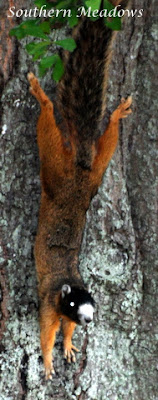Roadside Wildflowers
A good part of my days are spent in my car as chauffeur to my children or driving myself to the many volunteer activities I am involved in. As tedious as this is most of the time, in the spring driving along Georgia's roadways is a sight to behold.
There are gorgeous wildflower everywhere! It makes driving more bearable and truth be told it can be a distraction because I become entranced by the beautiful flowers when I should be watching the road.
Mrs. Virginia Hand Callaway (co-founder of Callaway Gardens) as chair of the Birds and Wildflower Committee of The Garden Club of Georgia, lead the movement to plant and protect wildflowers on Georgia's roadsides back in 1974.
In 1998 Georgians voted to amend the Constitution to create a roadside enhancement and beautification fund which is supplemented by the sale of special wildflower motor vehicle tags.
The beautification fund helps preserve and restore native flora. It also supports research projects on the uses and value of planting native flora and native seed sources as well as the planting of trees, shrubs and ground covers. Since native plants have already adapted to the climate and soil conditions they do not require a lot of labor, equipment or irrigation. Grassy roadways typically require mowing at least three times a year, while the wildflower plots are mowed only once after the plants have shed their petals and the seed heads have dried.
The Department of Transportation tries to plant at least an acre of wildflowers in each county every year and additional beds are added through funds raised by the sales of wildflower license plates. Each plot lasts three to four years before reseeding is necessary. Here is a list of wildflowers that you can see along the roadside while driving in Georgia.
There are gorgeous wildflower everywhere! It makes driving more bearable and truth be told it can be a distraction because I become entranced by the beautiful flowers when I should be watching the road.
Mrs. Virginia Hand Callaway (co-founder of Callaway Gardens) as chair of the Birds and Wildflower Committee of The Garden Club of Georgia, lead the movement to plant and protect wildflowers on Georgia's roadsides back in 1974.
In 1998 Georgians voted to amend the Constitution to create a roadside enhancement and beautification fund which is supplemented by the sale of special wildflower motor vehicle tags.
The beautification fund helps preserve and restore native flora. It also supports research projects on the uses and value of planting native flora and native seed sources as well as the planting of trees, shrubs and ground covers. Since native plants have already adapted to the climate and soil conditions they do not require a lot of labor, equipment or irrigation. Grassy roadways typically require mowing at least three times a year, while the wildflower plots are mowed only once after the plants have shed their petals and the seed heads have dried.
- Black-Eyed Susan (Rudbeckia hirta)
- Bur-Marigold/ Tickseed (Bidens aristosa)
- Clasping Coneflower (Rudbeckia amplexicaulis)
- Cornflower (Centaurea cyanus)
- Corn Poppy (Papaver rhoeas)
- Cosmos (Cosmos bipinnatus)
- Drummond Phlox (Phlox drummondii)
- Golden Wave Coreopsis (Coreopsis basalis)
- Indian Blanket/ Firewheel (Gaillardia pulchella)
- Lanceleaf Coreopsis (Coreopsis lanceolata)
- Lemon Mint (Monarda citriodora • Mexican Hat (Ratibida columnaris)
- Narrow-leaved Sunflower (Helianthus angustifolius)
- Perennial Gaillardia (Gaillardia aristata)
- Plains Coreopsis (Coreopsis tinctoria)
- Prairie Coneflower (Ratibida columnaris)
- Showy Primrose (Oenothera speciosa)
- Threadleaf Coreopsis (Coreopsis grandiflora)
- Tickseed/Lance-leaved Coreopsis (Coreopsis lanceolata)





.png)
